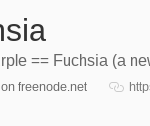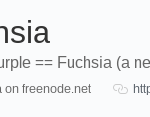
Google’s secret Operating System called Fuchsia is picking up steam of late, they’ve just launched a new logo, and there’s a few new hires appearing who are working on the system.
Fuchsia first showed up in August last year, it’s a new operating system from Google but the major difference to things like Chrome OS and Android which run on the Linux Kernel is that it runs on ‘Magenta’ which is based on the little Kernel project making it ideal for embedded systems.
When the Git repository first went up, the logo was a simple magenta square – but it now has an infinity loop style logo that states rather simply that the project has progressed into a more public and higher profile arena.
The Fuchsia project has also picked up some steam in terms of functionality. When it first launched, there was limited functionality when compiled, but it now apparently has a working device emulator that was able to send a tweet. The Emulator is apparently QEMU – ‘a generic and open source machine emulator and virtualizer’.
Hello World. This is the first tweet sent on a #Fuchsia device (emulator).
— David Yang (@dvdwasibi) March 10, 2017
That emulator is apparently running a number of things including what appears to be a webkit browser that runs on the Armadillo user shell in Fuchsia. This could be dart based flutter or c++ built into the emulator though. A build of Chromium will surely be next on their list of things to build for Fuchsia

There’s a lot of people working on Fuchsia, including at least one Australian, and there seems to be more joining the project all the time based on the number of engineers listing Fuchsia in their Twitter and Linkedin profiles.
Google owns a big market share for smartphones with Android, and they’ve made great moves of late with their moves in the education market with Chrome OS where it’s fast becoming the dominant OS. Fuchsia represents an opportunity to become a dominant force in embedded systems and IoT devices that are growing in popularity.
Fuchsia started out as what appeared to be an experiment, but over the past 7 months, it appears to have picked up a lot of steam. It’s by no means ready for a product release, but it’s progressing and we hope to see more about it soon.






